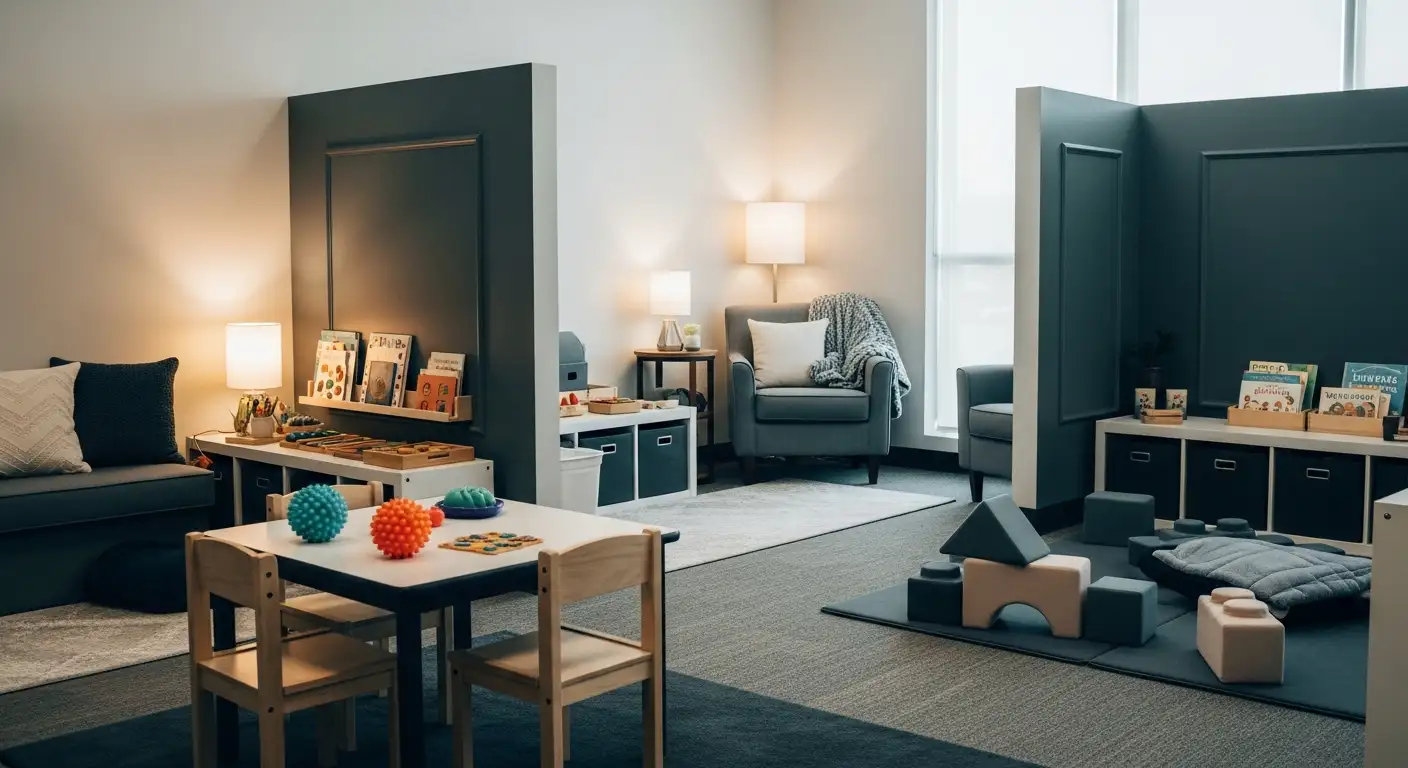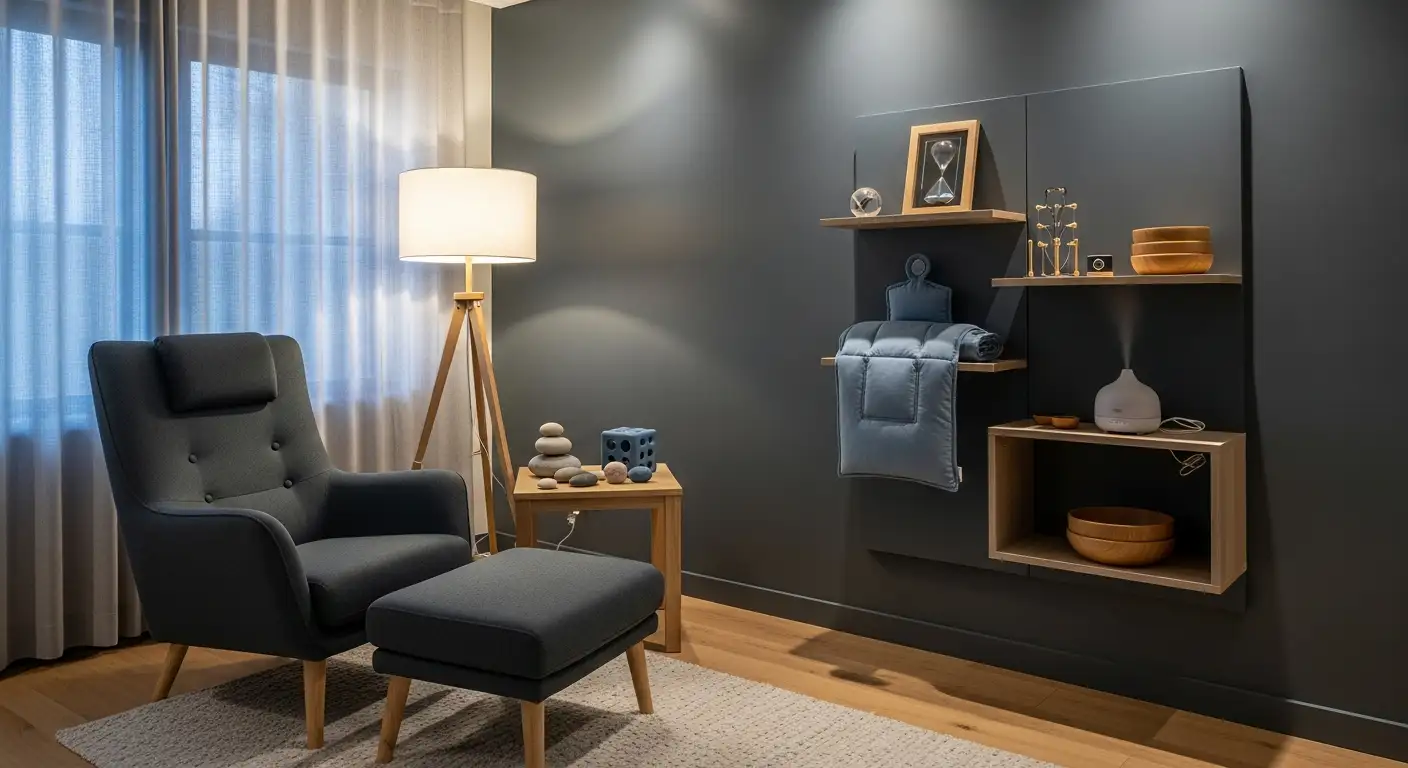The Foundation of Effective Behavior Goals
Creating effective behavioral goals is essential for guiding students' progress, especially within special education. Well-crafted goals serve as a roadmap for teaching social, emotional, and functional skills, while fostering positive changes in behavior. This article explores comprehensive strategies, practical examples, and best practices to help educators develop meaningful, measurable, and achievable behavioral goals that support student independence and success.
Understanding the Core Principles of Behavioral Goals
Why is positive framing important in IEP behavioral goals?
Behavioral goals should emphasize what the student WILL do, rather than what they won’t do. Positively stated goals focus on teaching and reinforcing prosocial behaviors and specific skills. For example, instead of aiming to reduce disruptive behavior, a goal might be for a student to raise their hand to ask for help. This positive approach fosters motivation, builds confidence, and encourages students to adopt desirable behaviors.
How should goals concentrate on skills and outcomes?
Goals should be skill or outcome-focused, targeting specific behaviors and competencies the student needs to develop. These might include asking for help, identifying emotions, initiating peer interactions, or managing classroom routines independently. Such targeted goals promote meaningful progress that supports the student’s personal and academic growth, and they are grounded in what the student will actually do.
How to ensure clarity, measurability, and realism in behavioral goals?
Effective goals are clearly defined, observable, and measurable. They include operational definitions that specify the exact behaviors targeted. For example, a goal may be to "initiate a conversation with peers three times during a class period" rather than vaguely stating "improve social interactions." Mастеrу levels should be realistic and aligned with the student’s current skills and pacing, recognizing individual differences. This facilitates accurate data collection and meaningful progress evaluation.
Are there examples of measurable behavioral goals?
Yes, there are numerous examples of measurable behavioral goals that are specific, observable, and include clear success criteria. These goals often specify the target behavior within a particular context, such as requesting breaks appropriately, initiating peer conversations, or transitioning independently into class. They incorporate detailed criteria for measurement, such as frequency, duration, or percentage of successful instances over a defined period. Additionally, effective goals focus on teaching replacement behaviors, are realistic yet ambitious, and are supported by appropriate data collection tools like observations and checklists. Overall, measurable behavioral goals are designed to track progress precisely and facilitate targeted interventions to promote meaningful behavioral development.
How can I write clear and effective behavioral goals for students and IEPs?
To write clear and effective behavioral goals for students and IEPs, goals should be specific, observable, measurable, and aligned with the student's individual needs and strengths. Incorporate the BEST criteria—Behavior, Evaluation, Specificity, and Timeliness—to ensure goals are meaningful and achievable within a set timeframe. Utilize behavior goal scaling to break down complex behaviors into manageable steps, facilitating progress monitoring and team understanding. Engage students and families in the goal-setting process to promote buy-in, self-advocacy, and generalization of skills. Additionally, incorporate data collection methods and potential functional behavior assessments (FBAs) where appropriate to tailor interventions and track progress effectively over time.
What factors should be considered when designing behavioral goals?
Behavioral goals should be linked to information gathered through Functional Behavior Assessments (FBAs), including skill deficits, behavior patterns, setting events, and student strengths. They should also be portable across different settings and staff, emphasizing skill outcomes over specific programs. Goals need to be realistic, reflecting what the student can achieve, and include supports like behavior support plans, accommodations, and service minutes when applicable. Additionally, they should promote independence, such as initiating tasks, requesting breaks, or managing conflicts, to prepare the student for real-life situations.
How do behavioral goals relate to functional assessments?
Goals are most effective when they are based on the information collected during FBAs. This data helps identify the specific behaviors to target, understand the contexts in which behaviors occur, and highlight the student’s strengths. Using FBA data ensures that goals are relevant, meaningful, and tailored to the student's unique circumstances, promoting successful skill acquisition and behavioral change.
What is the importance of measurable, observable behaviors?
Measurable and observable behaviors allow educators to objectively assess progress and determine when a goal has been mastered. Clear operational definitions help eliminate ambiguity, making it easier for staff to collect accurate data. Using tools like structured observations, permanent products, and checklists ensures consistent measurement, which supports accountability and facilitates data-driven decision making.
How do supports like accommodations and service minutes factor into behavioral goals?
Supports such as accommodations, behavioral support plans, and additional service minutes are essential when a student has a behavior goal. These supports provide the necessary environment and resources to help the student achieve the goal. For example, a student working on requesting breaks independently may need visual supports or additional coaching. Integrating these supports into the IEP helps ensure that the student has a structure in place to succeed.
How can goals promote independence and real-world functioning?
Goals focused on functional, everyday skills—such as managing peer conflicts, demonstrating self-regulation, initiating tasks, and requesting breaks—are crucial for independence. These skills prepare students for post-school settings and daily life. For instance, a goal might be for a student to independently ask for a break if overwhelmed, fostering self-advocacy. By targeting these practical skills, behavioral goals help students become more self-reliant and successful outside the classroom.
What are best practices for scaling behavioral goals?
Goals should include a baseline understanding of current performance, early progress markers, and long-term targets. Scaling involves gradually increasing independence, reducing supports, and raising the expectations as the student demonstrates success. For example, initially supported prompts may be phased out as the student gains mastery, ensuring continued growth and sustainability of behavior changes.
| Aspect | Description | Example | Support Tool |
|---|---|---|---|
| Focus | Positive, skill-based | Request help | Checklists |
| Measurement | Observable, precise | Raise hand 3 times / period | Structured observation |
| Realism | Achievable relative to peer group | Transition independently | Visual cues |
| Support | Use of accommodations | Visual schedule | Behavioral plan |
By adhering to these principles, educators can craft behavioral goals that are effective, motivating, and truly supportive of the student's growth toward independence and social functioning.
Key Components and Criteria for Behavior Goals
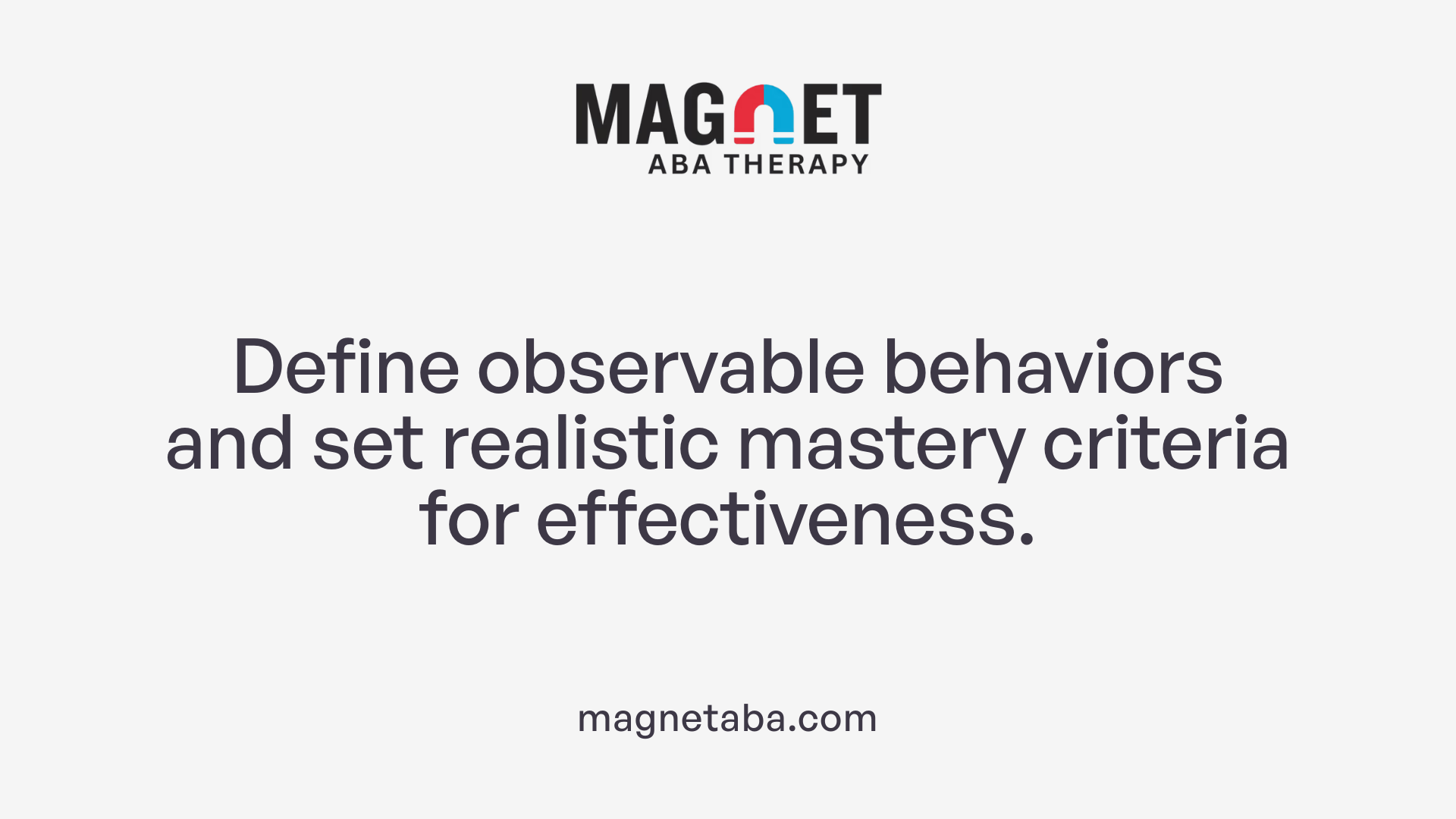
What are the main types of behavioral goals?
Behavioral goals in an Individualized Education Program (IEP) focus on developing positive skills and reducing problematic behaviors. These goals are designed to be measurable, specific, and meaningful to both the student's immediate needs and long-term success. There are primarily three types:
- Enhancing Positive Behaviors: These goals aim to increase actions like following routines, participating in class discussions, or demonstrating self-regulation.
- Reducing Problematic Behaviors: These focus on decreasing disruptive or maladaptive actions, such as outbursts or non-compliance, often through teaching alternative, prosocial behaviors.
- Teaching Replacement Behaviors: These involve instructing students on appropriate skills to replace negative actions, for example, asking for help instead of tantrums.
Goals are often related to functional skills essential for independence, like requesting a break or managing peer conflicts. They are developed based on detailed assessments like Functional Behavior Assessments (FBA). Even when behaviors seem straightforward, formal assessments help specify targeted actions and successful interventions.
Ultimately, the purpose of these goals is to support students in becoming more independent and socially competent, preparing them for academic success and future workplace environments.
Operational definitions and observations
Effective behavioral goals require clear, precise operational definitions. These definitions specify exactly what the target behavior looks like, making it observable and measurable. For example, instead of vague statements like "improve communication," a well-defined goal might specify, "Request a break by saying 'Can I have a break?'".
Observation plays a crucial role in collecting data about whether behaviors occur as targeted. Data collection methods should facilitate accuracy, often employing structured observations, checklists, or permanent products, which are tangible items indicating behavior occurrence.
Supports such as behavior support plans or accommodations might also be included in the goals. These plans outline the strategies and interventions to foster desired behaviors and are adjusted based on ongoing data.
Target behaviors and abstaining behaviors
Goals should explicitly target specific behaviors the student will perform and behaviors they will abstain from. For example, a goal might specify, "Student will raise hand to participate in class discussions" rather than "Student will not call out." Clear descriptions help ensure that the behavior is observable and measurable.
Including both actions to promote and behaviors to inhibit offers a comprehensive approach, especially when tied to functional assessments that reveal antecedents and setting events influencing behavior.
Realistic, ambitious, and individualized targets
Goals must be tailored to each student's capabilities. They should be challenging yet achievable within a reasonable timeframe.
Recognizing individual paces of learning is essential. For example, aiming for a student to stay on task for 15 minutes may be suitable initially, with a gradual increase in this duration.
Goals should also be aligned with peers’ performance and meaningful for the student's everyday life, emphasizing functional independence.
Data collection methods and criteria for mastery
Data collection is fundamental to measuring progress. The methods should be straightforward, reliable, and valid. Common tools include observation checklists, structured interviews, or permanent products like written responses.
Criteria for mastery should be realistic and based on the child's current skills. Typical benchmarks might be performing the target behavior correctly 80% of the time over a specified number of opportunities.
Mastery levels are set to encourage steady progress without setting unattainable expectations, supporting sustained behavior change.
| Aspect | Detail | Notes |
|---|---|---|
| Type of goals | Positive behaviors, problem reduction, replacement skills | Focus on developmental and functional skills |
| Operational definitions | Clear, specific descriptions | Ensure observable and measurable behaviors |
| Data collection methods | Checklists, observations, permanent products | Facilitate accuracy and reliability |
| Criteria for mastery | Achieving performance at a realistic threshold (e.g., 80%) | Based on individual baseline and potential |
| Targets | Realistic and individualized | Aligned with student's current abilities and growth potential |
By focusing on these components, IEP behavioral goals become effective tools for fostering meaningful progress in students' social, emotional, and functional skills.
Effective Strategies for Developing Behavior Goals
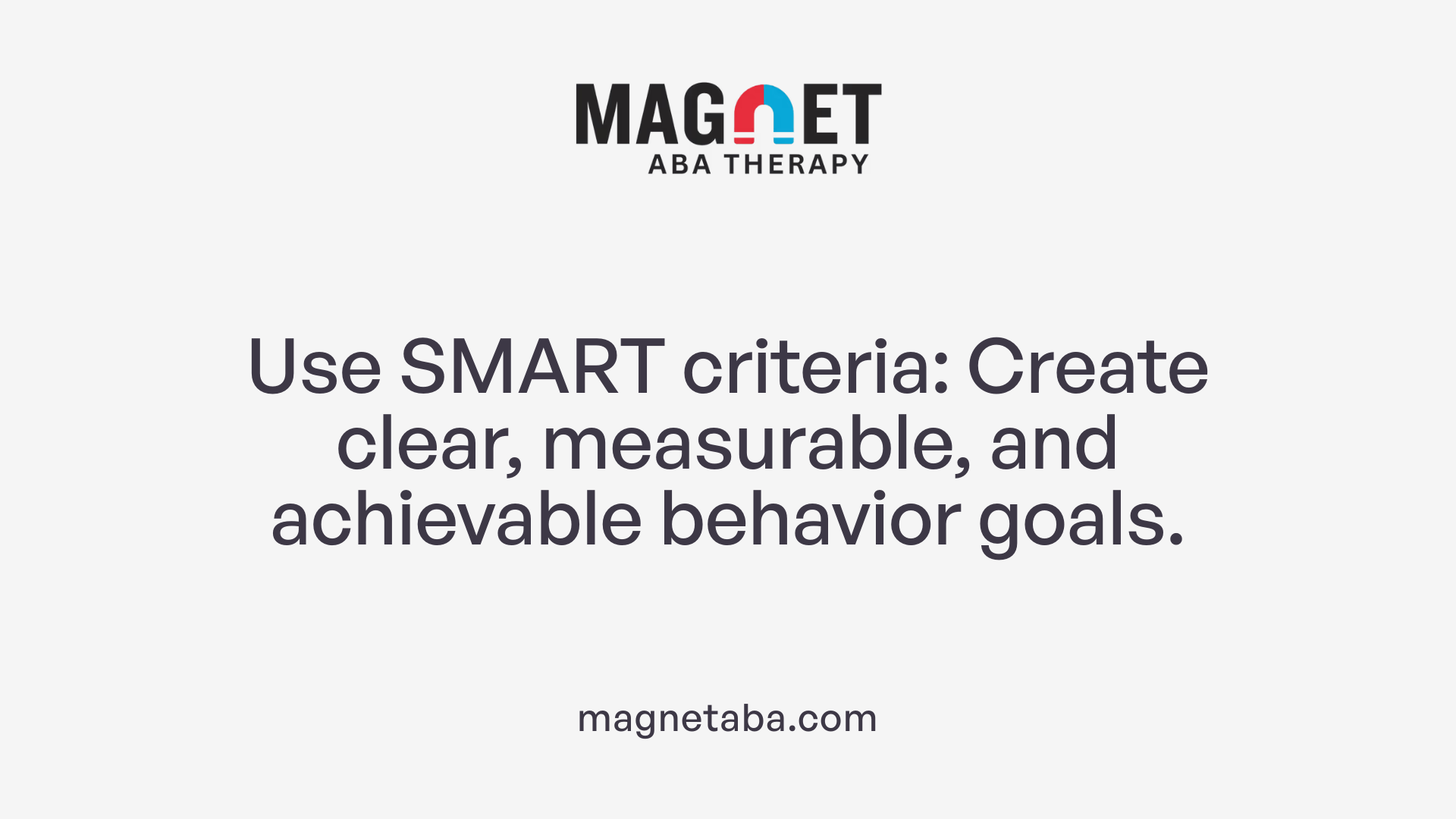
How do you develop effective behavior goals and plans, including examples and best practices?
Creating successful behavior goals begins with a comprehensive understanding of the student's current performance levels. Conducting a Functional Behavior Assessment (FBA) is an essential first step. The FBA helps identify the purpose behind specific behaviors by analyzing the triggers, setting events, behavior patterns, and strengths of the student.
Once the FBA provides a clear picture, a Behavior Intervention Plan (BIP) is developed. This plan should include goals that are positive, focused on skills or outcomes rather than merely eliminating negative behaviors. For example, instead of aiming to reduce disruptions, a goal might target the student's ability to request a break independently or transition between activities smoothly.
Goals should be written using the SMART criteria—Specific, Measurable, Achievable, Relevant, and Time-bound. For instance, a goal might state: "The student will independently request a five-minute break using a visual cue in 4 out of 5 opportunities across school days."
Best practices involve designing goals that promote the teaching of replacement behaviors—alternative actions that serve the same function as the problematic behavior. If a student engages in non-compliant behavior to escape tasks, the goal might focus on teaching the student to use a visual signal to request to take a break.
In addition, clear procedures for data collection are vital. Data should be accurate, consistent, and structured, enabling staff to monitor progress and adjust interventions as needed. Tools such as permanent products, structured observations, and behavioral checklists help ensure objectivity.
Staff training is another critical component. All team members must understand the goals, data collection methods, and strategies to support the student effectively. Consistency across settings and staff improves the likelihood of success.
Regular review of progress, using the data gathered, ensures goals remain relevant and achievable. Adjustments are made based on the student’s progress, ensuring that targets are realistically reachable and that the student continues to learn and grow.
Additionally, involving caregivers and the student whenever appropriate fosters a supportive environment for behavior change. This collaborative approach promotes generalization and maintenance of skills across different settings.
In summary, effective behavior plans are grounded in thorough assessment, clear and positive goal setting, data-driven decision making, staff training, and collaborative review, all aimed at building meaningful, functional skills for the student.
Ensuring Goals Are Motivating, Relevant, and Achievable
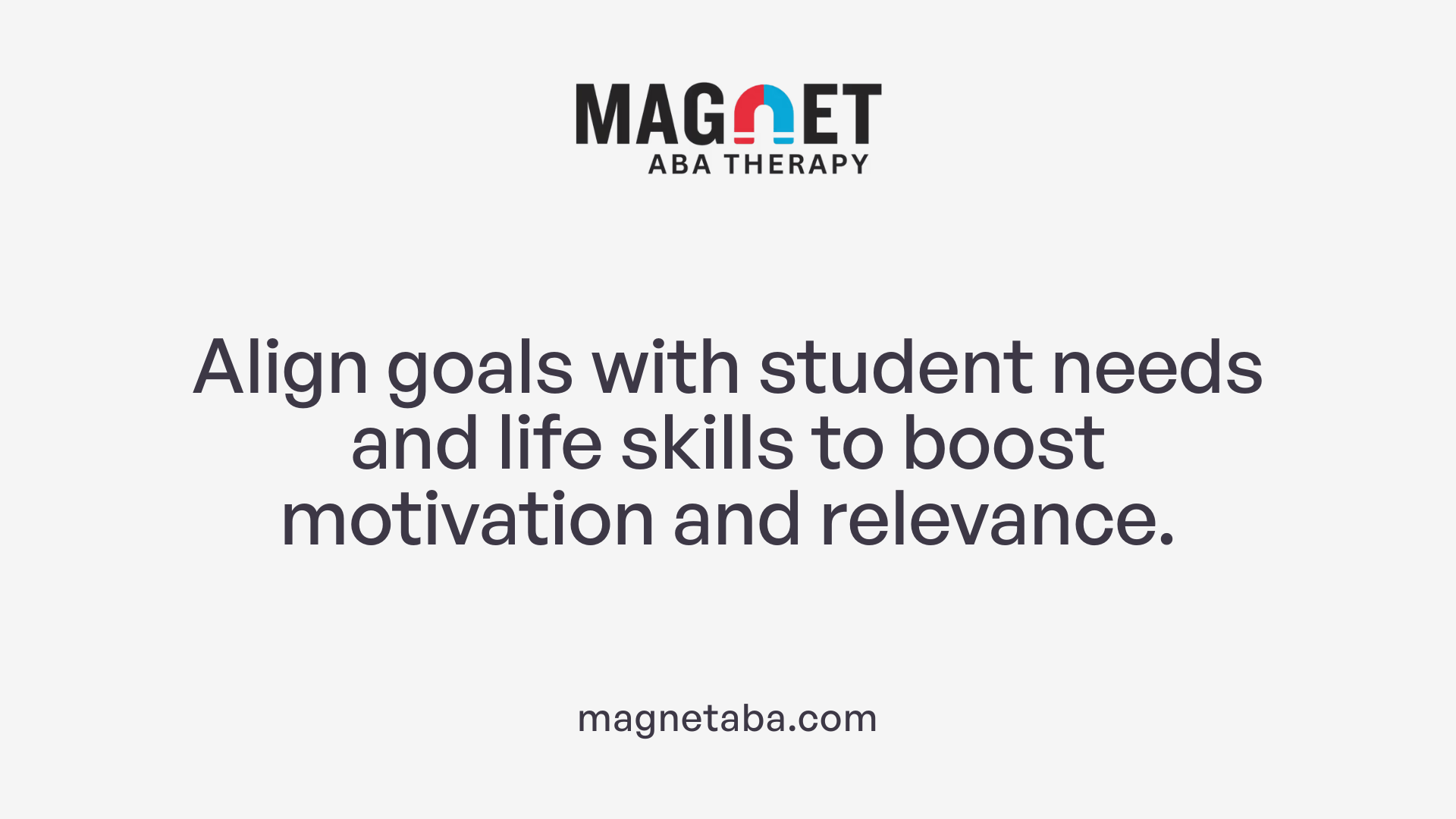
What are the key considerations to ensure behavior goals are meaningful and effective?
Developing impactful behavior goals requires thoughtful planning and alignment with the student’s individual needs. One of the most important aspects is crafting goals that are specific, measurable, realistic, and time-bound, often summarized by the SMART criteria. Clear, vivid descriptions of expected behaviors help increase understanding, motivation, and focus for both students and educators.
Goals should be grounded in comprehensive assessments like Functional Behavior Assessments (FBAs). These assessments identify the student's skill deficits, behavior patterns, set-ting events, and strengths. Using this information ensures that goals address actual needs and move the student toward functional, life-long skills.
Incorporating active support mechanisms, such as mentoring, coaching, or training, can boost the chances of success. These supports help reinforce correct behaviors and provide ongoing guidance.
Considering different types of goals—whether aimed at developing approach behaviors or reducing avoidance behaviors—ensures goals are well-rounded. Effective goals balance challenge and attainability, fostering self-efficacy and motivation.
Regular review and progress monitoring allow educators and families to gauge whether the student is on track. Action planning and feedback sessions are essential for making adjustments, celebrating successes, and maintaining momentum.
Goals should also be linked to real-life skills and post-school outcomes, making them meaningful beyond the classroom. These may include behaviors like requesting help, managing peer conflicts, or demonstrating self-regulation—skills vital for independence and success after school.
Engagement and student buy-in are crucial. When students understand that their goals are relevant to their lives and future aspirations, they are more likely to work towards achieving them.
Furthermore, involving families, caregivers, and other stakeholders in goal development ensures the goals are realistic and supported across environments. These collaborations increase consistency and reinforce the learned behaviors across settings.
Ultimately, effective behavioral goals are not only about reducing negative behaviors but also about teaching new, positive skills that are meaningful and applicable in everyday life. They should be crafted with consideration for individual capacity, cultural relevance, and practical application to foster motivation and sustainable progress.
Resources, Templates, and Tools for Effective Goal Setting
Where can I find resources or templates for developing behavioral goals and intervention plans?
Educators and professionals seeking practical tools to develop effective behavioral goals and intervention plans have several reliable online resources at their disposal. One prominent platform is Panorama Ed, which offers a variety of free, customizable templates specifically designed for Behavior IEP Goals. These templates guide users through the process of setting clear, measurable, and meaningful goals that align with functional behavior assessments (FBAs). They include prompts for defining observable behaviors, setting realistic mastery criteria, and incorporating progress monitoring measures.
Panorama Ed's resources emphasize the importance of basing goals on data collected systematically, understanding the function of behaviors, and involving a multidisciplinary team in plan development. The templates help ensure that goals focus on teaching prosocial, replacement behaviors that promote independence and social success.
Another valuable platform is Venngage, which offers a wide range of editable templates suitable for behavior change initiatives. These templates often feature visual elements and interactive features that make planning engaging and accessible. They support the development of structured plans targeting social skills, self-regulation, and classroom management, especially for students with autism spectrum disorders (ASD).
Both platforms stress that effective behavioral goals should be specific, observable, and achievable. They also highlight the importance of integrating data collection tools, such as structured observations or permanent products, to measure progress accurately. By leveraging these resources, educators can craft behavior goals that are tailored to individual student needs and are adaptable over time.
For additional support, many educational websites provide checklists and research-backed principles to guide the goal-setting process. These include ensuring goals are positive, outcome-focused, and linked to functional and real-life improvements.
How can data collection methods facilitate accuracy and realistic mastery criteria?
Accurate data collection is fundamental to setting and monitoring behavioral goals effectively. Using structured tools like direct observations, permanent products, and frequency counts helps educators gather precise, objective evidence of student behavior.
Implementing consistent data collection methods allows for realistic and individualized mastery criteria. For example, if a student needs to improve on requesting breaks appropriately, data might include the number of appropriate requests made in a day or the percentage of classroom transitions where they independently ask for a break. These measures should reflect what is reasonably achievable given the student’s current capabilities and learning pace.
Moreover, data should be collected across different settings and times to obtain a comprehensive picture of the student’s behavior pattern. This ensures that goals are not only measurable but also meaningful, promoting positive outcomes that translate across environments.
Clear operational definitions of targeted behaviors are essential. These definitions specify exactly what constitutes a target behavior, making observations more consistent and ensuring that all team members assess behavior similarly. When mastery levels are set, they need to be attainable yet challenging, considering the student’s strengths, previous progress, and peer performance.
In summary, structured and systematic data collection enhances goal accuracy, supports realistic expectations, and provides ongoing feedback to inform instructional decisions.
How should goals be connected to functional behavior assessments and student strengths?
Goals derived from Functional Behavior Assessments (FBAs) are more effective because they address underlying reasons for behaviors. The data collected through FBAs reveal skill deficits, behavior patterns, setting events, and student strengths, all of which inform goal development.
When writing behavioral goals, professionals should focus on what the student will do—such as initiating peer interactions, following routines independently, or demonstrating self-regulation—rather than on what they won’t do. For example, a goal might be: “The student will request a break politely using a gesture or verbal cue in 4 out of 5 opportunities.”
Linking goals to FBA findings ensures that targets are functional and personalized. For instance, if an FBA identifies that a student struggles with peer conflict due to difficulty with emotion regulation, a corresponding goal might involve teaching coping strategies or recognizing emotions.
Furthermore, incorporating strengths identified during assessments encourages a strengths-based approach, promoting skills that foster independence and social participation. This positive framing enhances motivation and supports the development of replacement behaviors.
By anchoring goals in a comprehensive understanding of the student’s behavior patterns and abilities, teams can develop interventions that are both purposeful and sustainable. These goals guide systematic teaching of skills that replace problematic behaviors, leading to meaningful improvements in daily life.
How can goals be made portable across settings and staff?
To ensure continuity and consistency, behavioral goals should be designed to be transferable across various settings and staff members. This entails focusing on specific, observable behaviors and skill outcomes rather than on context-specific procedures or programs.
Clear operational definitions and consistent data collection methods are essential. For example, if a goal involves requesting a break, all staff should understand what constitutes an appropriate request, whether verbal, gestural, or through a communication device.
Goals should also emphasize skills that are functional and relevant in multiple environments—such as classroom routines, lunchroom behavior, or community settings—so that progress in one area supports success elsewhere.
Supporting materials such as visual cues, social stories, or step-by-step routines help reinforce skills across different settings. Training staff on these strategies ensures everyone understands the expectations and can reinforce behaviors consistently.
It is also beneficial to include supports like behavior support plans, accommodations, and service minutes in the IEP. These resources aid staff in implementing the goals effectively and adjusting strategies as needed.
Ultimately, portable goals are grounded in the principle that teaching functional, socially valid skills benefits the student across all areas of their life, fostering independence and social integration.
What are the critical components of writing effective behavioral goals?
Effective behavioral goals incorporate several essential elements that make them measurable, relevant, and achievable. First, they specify the targeted behavior in clear, observable terms. This includes defining what the student will do, how often, and under what conditions.
Second, goals include criteria for mastery that are realistic and tied to measurable data. For example, “Remaining on task for 15 minutes” or “Raising hand to contribute during class discussions at least 4 out of 5 times.” These criteria should reflect the student’s current level and be a step toward greater independence.
Third, the goals are functional and directly related to the student’s needs and future success—such as social participation, self-regulation, or independent living skills. They are aligned with the results of the FBA and support post-school outcomes.
Support mechanisms, like behavior support plans, accommodations, and related services, are included to facilitate achievement. These supports are documented in the IEP to ensure consistent implementation.
Finally, effective goals are written with input from a multidisciplinary team, caregivers, and the student when appropriate. They should foster motivation, reinforce positive actions, and be adaptable as the student progresses.
By carefully integrating these components, IEP goals become powerful tools that promote meaningful growth and self-sufficiency.
| Aspect | Description | Example |
|---|---|---|
| Clarity | Specific and observable behaviors | “Raise hand to speak” |
| Measurability | Defined criteria for success | “At least 4 out of 5 opportunities” |
| Realism | Achievable given the student’s current skills | Based on baseline data and individual pace |
| Functionality | Relevant to daily life and future independence | Requesting breaks, participating in discussions |
| Data Collection | Clear methods to monitor progress | Structured observations, permanent products |
| Supports | Accommodations, behavior plans, services | Visual cues, social stories, coaching |
Utilizing these principles and resources, educators can design behavioral goals that effectively support student development, independence, and social success.
Ensuring Continuity and Portability of Behavior Goals
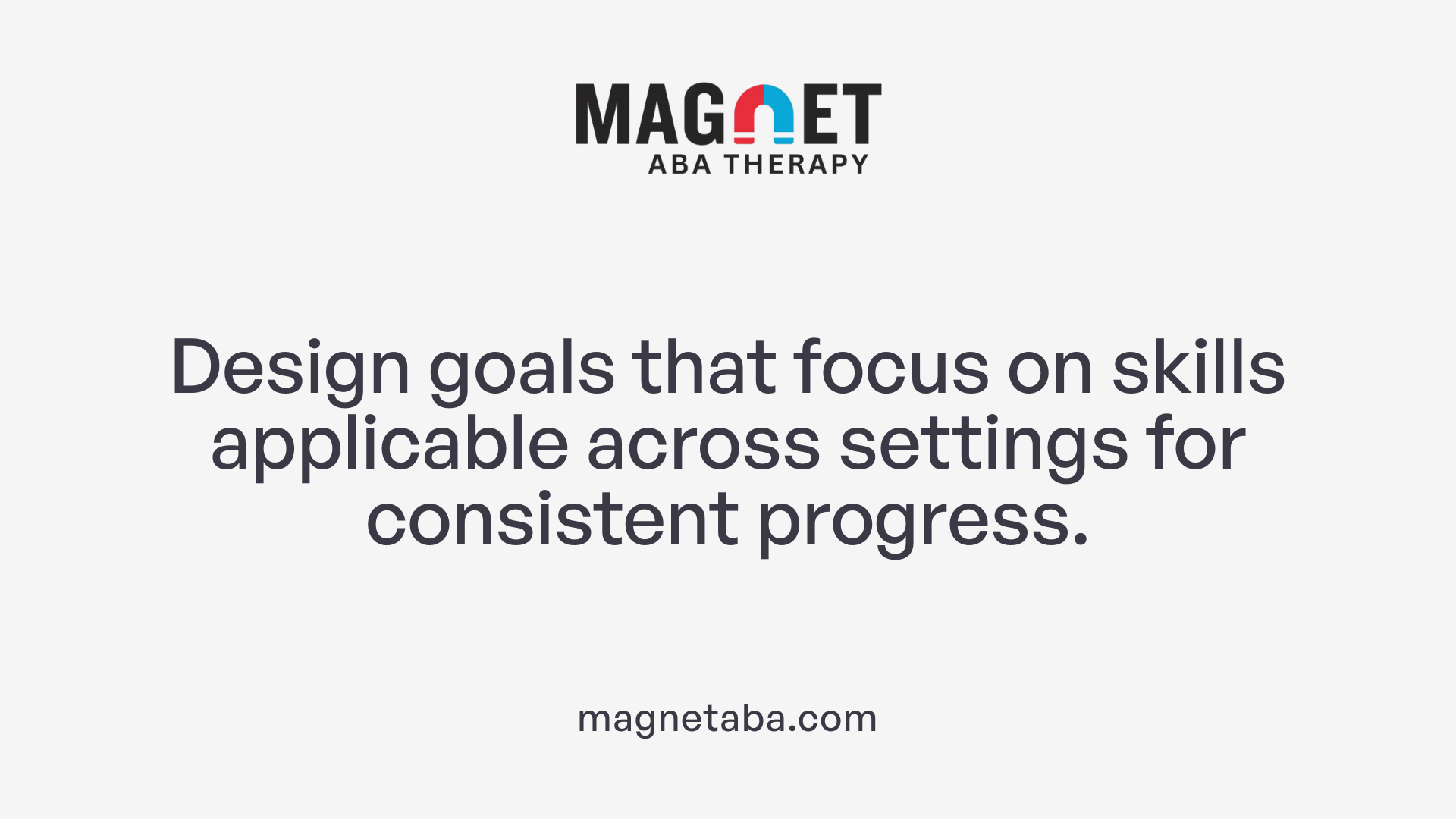
What are the main types of behavioral goals?
Behavioral goals in the IEP are primarily designed to encourage positive action and skill development. They focus on increasing desirable behaviors, reducing problematic ones, and teaching replacement behaviors that are more adaptive. These goals are usually specific, measurable, and targeted at key areas such as self-regulation, communication, social skills, and daily routines.
Most behavioral goals aim to enhance independence and social functioning, whether it's managing conflicts, requesting breaks, or following classroom routines. They are often built around functional skills that students need in real-world settings. Progress is typically tracked through direct observation, structured data collection, and feedback.
In some cases, behavioral goals are established without a formal Functional Behavior Assessment (FBA), especially when behaviors are mild or firmly understood. However, complex or challenging behaviors usually require comprehensive assessment to craft effective goals.
Overall, the purpose behind these goals is to support students in becoming more independent and socially competent, preparing them effectively for academic success, social integration, and future workplace environments.
Summary and Final Tips for Effective Behavior Goal Writing
How do you develop effective behavior goals and plans, including examples and best practices?
Developing effective behavior goals begins with a comprehensive understanding of the student's current skills, which is obtained through a Functional Behavior Assessment (FBA). The FBA helps identify the reasons behind specific behaviors, guiding the creation of targeted intervention strategies.
Once the assessment is complete, a Behavior Intervention Plan (BIP) is crafted. This plan should outline clear, measurable, and realistic goals that focus on teaching positive, prosocial behaviors rather than merely addressing negative actions. Goals should be written in positive terms, such as "student will ask for help appropriately" or "student will identify and label emotions." They need to be attainable and aligned with the child's capabilities, with mastery levels defined in observable, operational terms.
Effective goals also emphasize skill development that supports independence and real-life functioning, such as requesting breaks independently or initiating peer interactions. The strategies used should include teaching replacement behaviors, modifying the environment to reduce triggers, and reinforcing positive actions.
For example, a goal might be: "Student will raise hand to participate in classroom discussions at least 4 out of 5 opportunities, as measured through structured observations." Regular data collection through structured observations or permanent products provides accurate measurement of progress.
Behavioral goals should be linked to data collected via FBA, including student strengths, behavior patterns, potential setting events, and skill deficits. Supports like behavior plans, accommodations, and service minutes should be incorporated when relevant.
Monitoring progress involves collecting data frequently, reviewing it systematically, and adjusting goals and strategies as needed. Goals should be scalable, starting from baseline performance and gradually increasing in complexity to promote sustained development.
Involving all stakeholders—teachers, parents, and specialists—in goal setting and review ensures the plan remains relevant and effective. Training staff and providing support through coaching or mentoring helps maintain consistency in implementing strategies.
In summary, the most effective behavior goals are those that are well defined, measurable, aligned with functional needs, and adaptable based on ongoing data analysis. By focusing on teaching appropriate, replacement behaviors and systematically monitoring progress, educators can promote meaningful change that supports the student's independence and success in various settings.
Bringing It All Together for Successful Behavior Change
Writing effective behavioral goals involves a strategic blend of clarity, data-informed decision-making, and relevance to everyday life skills. Goals should be positive, focused on observable behaviors, and based on thorough assessments. Incorporating stakeholder input, setting realistic yet ambitious targets, and regularly reviewing progress are vital steps in creating sustainable changes. Utilizing available resources, templates, and structured approaches ensures that goals are functional, measurable, and adaptable across environments. Ultimately, well-crafted behavioral goals are instrumental in fostering independence, social competence, and post-school success for students receiving special education services.
References
- [PDF] Process and Standards for Writing Behavioral IEP Goals
- [PDF] Writing Meaningful and Measurable Social/Behavior Goals
- Behavior Goals for an IEP: 101 Examples incl. Adaptive Behavior ...
- It's important to set behavioral goals | It's Your Yale
- IEP Goal Bank: 10+ Measurable Goals You Can Start Using Right ...
- [PDF] Behavior Intervention Plan Practice Guide
- Behavior Intervention Plan (BIP): The Complete Guide to Writing a ...


